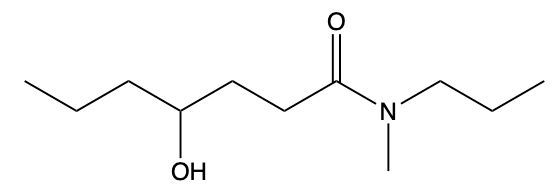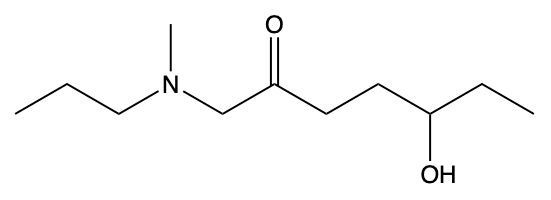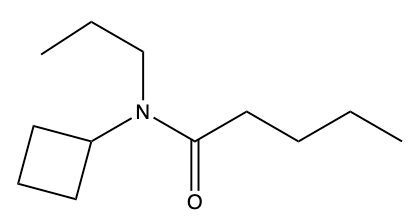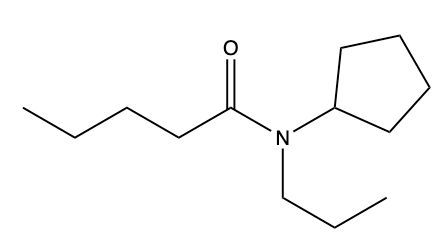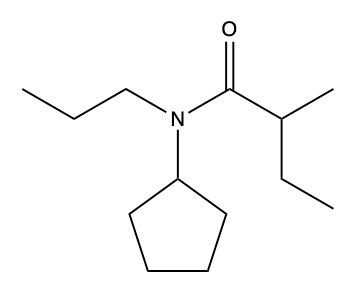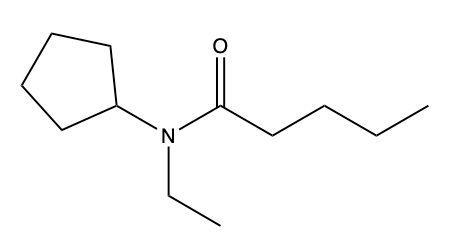Now recall that amides consist of a carbonyl group connected to a nitrogen, which could have its origins from an amine group. Amides can be classified as either being primary, secondary, or tertiary. Here we have an example of an amide: at the far right, we have our carbonyl connected to our nitrogen group. Whether you're primary, secondary, or tertiary is based on how many carbons are directly attached to the nitrogen. In this first example, there is only one carbon directly attached to the nitrogen, so this is a primary amide. For the next one, there are two carbons directly attached to the nitrogen, so this is secondary. And then here there are three, so this is tertiary. That's how we look at the substitution around amides: it's the number of carbons directly attached to the nitrogen.
- 1. Matter and Measurements4h 29m
- What is Chemistry?5m
- The Scientific Method9m
- Classification of Matter16m
- States of Matter8m
- Physical & Chemical Changes19m
- Chemical Properties8m
- Physical Properties5m
- Intensive vs. Extensive Properties13m
- Temperature (Simplified)9m
- Scientific Notation13m
- SI Units (Simplified)5m
- Metric Prefixes24m
- Significant Figures (Simplified)11m
- Significant Figures: Precision in Measurements7m
- Significant Figures: In Calculations19m
- Conversion Factors (Simplified)15m
- Dimensional Analysis22m
- Density12m
- Specific Gravity9m
- Density of Geometric Objects19m
- Density of Non-Geometric Objects9m
- 2. Atoms and the Periodic Table5h 23m
- The Atom (Simplified)9m
- Subatomic Particles (Simplified)12m
- Isotopes17m
- Ions (Simplified)22m
- Atomic Mass (Simplified)17m
- Atomic Mass (Conceptual)12m
- Periodic Table: Element Symbols6m
- Periodic Table: Classifications11m
- Periodic Table: Group Names8m
- Periodic Table: Representative Elements & Transition Metals7m
- Periodic Table: Elemental Forms (Simplified)6m
- Periodic Table: Phases (Simplified)8m
- Law of Definite Proportions9m
- Atomic Theory9m
- Rutherford Gold Foil Experiment9m
- Wavelength and Frequency (Simplified)5m
- Electromagnetic Spectrum (Simplified)11m
- Bohr Model (Simplified)9m
- Emission Spectrum (Simplified)3m
- Electronic Structure4m
- Electronic Structure: Shells5m
- Electronic Structure: Subshells4m
- Electronic Structure: Orbitals11m
- Electronic Structure: Electron Spin3m
- Electronic Structure: Number of Electrons4m
- The Electron Configuration (Simplified)22m
- Electron Arrangements5m
- The Electron Configuration: Condensed4m
- The Electron Configuration: Exceptions (Simplified)12m
- Ions and the Octet Rule9m
- Ions and the Octet Rule (Simplified)8m
- Valence Electrons of Elements (Simplified)5m
- Lewis Dot Symbols (Simplified)7m
- Periodic Trend: Metallic Character4m
- Periodic Trend: Atomic Radius (Simplified)7m
- 3. Ionic Compounds2h 18m
- Periodic Table: Main Group Element Charges12m
- Periodic Table: Transition Metal Charges6m
- Periodic Trend: Ionic Radius (Simplified)5m
- Periodic Trend: Ranking Ionic Radii8m
- Periodic Trend: Ionization Energy (Simplified)9m
- Periodic Trend: Electron Affinity (Simplified)8m
- Ionic Bonding6m
- Naming Monoatomic Cations6m
- Naming Monoatomic Anions5m
- Polyatomic Ions25m
- Naming Ionic Compounds11m
- Writing Formula Units of Ionic Compounds7m
- Naming Ionic Hydrates6m
- Naming Acids18m
- 4. Molecular Compounds2h 18m
- Covalent Bonds6m
- Naming Binary Molecular Compounds6m
- Molecular Models4m
- Bonding Preferences6m
- Lewis Dot Structures: Neutral Compounds (Simplified)8m
- Multiple Bonds4m
- Multiple Bonds (Simplified)6m
- Lewis Dot Structures: Multiple Bonds10m
- Lewis Dot Structures: Ions (Simplified)8m
- Lewis Dot Structures: Exceptions (Simplified)12m
- Resonance Structures (Simplified)5m
- Valence Shell Electron Pair Repulsion Theory (Simplified)4m
- Electron Geometry (Simplified)8m
- Molecular Geometry (Simplified)11m
- Bond Angles (Simplified)11m
- Dipole Moment (Simplified)15m
- Molecular Polarity (Simplified)7m
- 5. Classification & Balancing of Chemical Reactions3h 17m
- Chemical Reaction: Chemical Change5m
- Law of Conservation of Mass5m
- Balancing Chemical Equations (Simplified)13m
- Solubility Rules16m
- Molecular Equations18m
- Types of Chemical Reactions12m
- Complete Ionic Equations18m
- Calculate Oxidation Numbers15m
- Redox Reactions17m
- Spontaneous Redox Reactions8m
- Balancing Redox Reactions: Acidic Solutions17m
- Balancing Redox Reactions: Basic Solutions17m
- Balancing Redox Reactions (Simplified)13m
- Galvanic Cell (Simplified)16m
- 6. Chemical Reactions & Quantities2h 35m
- 7. Energy, Rate and Equilibrium3h 46m
- Nature of Energy6m
- First Law of Thermodynamics7m
- Endothermic & Exothermic Reactions7m
- Bond Energy14m
- Thermochemical Equations12m
- Heat Capacity19m
- Thermal Equilibrium (Simplified)8m
- Hess's Law23m
- Rate of Reaction11m
- Energy Diagrams12m
- Chemical Equilibrium7m
- The Equilibrium Constant14m
- Le Chatelier's Principle23m
- Solubility Product Constant (Ksp)17m
- Spontaneous Reaction10m
- Entropy (Simplified)9m
- Gibbs Free Energy (Simplified)18m
- 8. Gases, Liquids and Solids3h 25m
- Pressure Units6m
- Kinetic Molecular Theory14m
- The Ideal Gas Law18m
- The Ideal Gas Law Derivations13m
- The Ideal Gas Law Applications6m
- Chemistry Gas Laws16m
- Chemistry Gas Laws: Combined Gas Law12m
- Standard Temperature and Pressure14m
- Dalton's Law: Partial Pressure (Simplified)13m
- Gas Stoichiometry18m
- Intermolecular Forces (Simplified)19m
- Intermolecular Forces and Physical Properties11m
- Atomic, Ionic and Molecular Solids10m
- Heating and Cooling Curves30m
- 9. Solutions4h 10m
- Solutions6m
- Solubility and Intermolecular Forces18m
- Solutions: Mass Percent6m
- Percent Concentrations10m
- Molarity18m
- Osmolarity15m
- Parts per Million (ppm)13m
- Solubility: Temperature Effect8m
- Intro to Henry's Law4m
- Henry's Law Calculations12m
- Dilutions12m
- Solution Stoichiometry14m
- Electrolytes (Simplified)13m
- Equivalents11m
- Molality15m
- The Colligative Properties15m
- Boiling Point Elevation16m
- Freezing Point Depression9m
- Osmosis16m
- Osmotic Pressure9m
- 10. Acids and Bases3h 29m
- Acid-Base Introduction11m
- Arrhenius Acid and Base6m
- Bronsted Lowry Acid and Base18m
- Acid and Base Strength17m
- Ka and Kb12m
- The pH Scale19m
- Auto-Ionization9m
- pH of Strong Acids and Bases9m
- Acid-Base Equivalents14m
- Acid-Base Reactions7m
- Gas Evolution Equations (Simplified)6m
- Ionic Salts (Simplified)23m
- Buffers25m
- Henderson-Hasselbalch Equation16m
- Strong Acid Strong Base Titrations (Simplified)10m
- 11. Nuclear Chemistry56m
- BONUS: Lab Techniques and Procedures1h 38m
- BONUS: Mathematical Operations and Functions47m
- 12. Introduction to Organic Chemistry1h 34m
- 13. Alkenes, Alkynes, and Aromatic Compounds2h 12m
- 14. Compounds with Oxygen or Sulfur1h 6m
- 15. Aldehydes and Ketones1h 1m
- 16. Carboxylic Acids and Their Derivatives1h 11m
- 17. Amines38m
- 18. Amino Acids and Proteins1h 51m
- 19. Enzymes1h 37m
- 20. Carbohydrates1h 46m
- Intro to Carbohydrates4m
- Classification of Carbohydrates4m
- Fischer Projections4m
- Enantiomers vs Diastereomers8m
- D vs L Enantiomers8m
- Cyclic Hemiacetals8m
- Intro to Haworth Projections4m
- Cyclic Structures of Monosaccharides11m
- Mutarotation4m
- Reduction of Monosaccharides10m
- Oxidation of Monosaccharides7m
- Glycosidic Linkage14m
- Disaccharides7m
- Polysaccharides7m
- 21. The Generation of Biochemical Energy2h 8m
- 22. Carbohydrate Metabolism2h 22m
- 23. Lipids2h 26m
- Intro to Lipids6m
- Fatty Acids25m
- Physical Properties of Fatty Acids6m
- Waxes4m
- Triacylglycerols12m
- Triacylglycerol Reactions: Hydrogenation8m
- Triacylglycerol Reactions: Hydrolysis13m
- Triacylglycerol Reactions: Oxidation7m
- Glycerophospholipids15m
- Sphingomyelins13m
- Steroids15m
- Cell Membranes7m
- Membrane Transport10m
- 24. Lipid Metabolism1h 45m
- 25. Protein and Amino Acid Metabolism1h 37m
- 26. Nucleic Acids and Protein Synthesis2h 54m
- Intro to Nucleic Acids4m
- Nitrogenous Bases16m
- Nucleoside and Nucleotide Formation9m
- Naming Nucleosides and Nucleotides13m
- Phosphodiester Bond Formation7m
- Primary Structure of Nucleic Acids11m
- Base Pairing10m
- DNA Double Helix6m
- Intro to DNA Replication20m
- Steps of DNA Replication11m
- Types of RNA10m
- Overview of Protein Synthesis4m
- Transcription: mRNA Synthesis9m
- Processing of pre-mRNA5m
- The Genetic Code6m
- Introduction to Translation7m
- Translation: Protein Synthesis18m
Naming Amides: Study with Video Lessons, Practice Problems & Examples
 Created using AI
Created using AIAmides are organic compounds featuring a carbonyl group (C=O) linked to a nitrogen atom (N), derived from amines. They can be classified as primary, secondary, or tertiary based on the number of carbon atoms attached to the nitrogen. IUPAC naming involves changing the suffix from "oic acid" to "amide." Common naming follows similar rules, using prefixes for substituents. Understanding amides is crucial in organic chemistry, particularly in the context of functional groups and their reactivity in various chemical reactions.
Intro to Amides Concept 1
Video transcript
Intro to Amides Example 1
Video transcript
So here we have to classify each of the given compounds as primary, secondary, or tertiary amides, or neither. Now here, if we take a look, this is an amide because we have a carbonyl connected to a nitrogen directly, and there's only one carbon directly connected to that nitrogen, so it is a primary amide. For the next one, there is no carbonyl present, so it's just sp3 carbons connected to a nitrogen. So this is actually an amine, but we're not asking about amines, so we'll put neither. For the next one, we have our carbonyl directly connected to a nitrogen. So this is an amide and there are 1, 2, 3 carbons directly attached to it. So this is a tertiary amide. Then finally, for this last one, it is also an amide, and it's directly connected to 1, 2 carbons in terms of the nitrogen. So this would be a secondary amide. And that's how we classify each of the given compounds.
IUPAC Rules for Naming Amides Concept 2
Video transcript
So when it comes to the IUPAC naming of amides, we're going to see the carbon chain with the carbonyl group is named as though it was a carboxylic acid. Remember, carboxylic acids end with oic acid. So what we do here is we modify the ending from oic acid to just amide. And our naming convention will be our substituents that are connected to our parent. And we're modifying the ending from again oic acid to amide. So this is the approach we're going to take when it comes to IUPAC naming of different types of amides that we'll see.
IUPAC Rules for Naming Amides Example 2
Video transcript
Provide a systematic name for the following amide. Now, here's step 1: we have to identify the alkyl group or groups connected to the nitrogen atom. So, we're talking about this right here. That is a one-carbon alkyl group, so it's a methyl group. Next, we're going to name the alkyl groups as substituents, which means they're going to go at the beginning of the name. And we're going to say here, n, and this is important, it has to be italicized. This will represent an n substituent, and it's written before the alkyl name to indicate it's connected to the nitrogen atom. Now, when more than one identical substituent, we're going to use the prefix di. Step 3 is we identify the carbon chain connected to the carbonyl group, so C double bond O. Step 4 is we figure out the length of the carbon chain starting from the carbonyl group, and we're going to say the carbonyl group as carbon number 1 is implied. From that point, we use the same rules that we learned in terms of naming esters to name this particular amide. Right. So, if we take a look here, so we have a methyl group here, and it's an n-methyl since it's connected to the nitrogen. Remember, it has to be written in italics. And then we're going to say here, this chain with the carbonyl is 1, 2, 3, 4, and 5. So that's 5 carbons there. And then we have this ethyl group over here that is also another substituent. It's located on carbon number 3. So, in alphabetical order, 'e' comes before 'm', so 3-ethyl-n-methyl. It's a 5 carbon chain, so that's pentane, but here we're going to change the e-ending of pentane to amide, so it's pentanamide. So, this will be the name of this particular amide.
Give IUPAC name for the following amide.
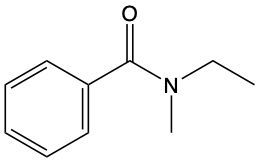
ethylmethylbenzoicamide
N-ethyl-N-methylbenzamide
ethylmethylbenzamide
N-methyl-N-ethylbenzoic amide
Draw structure from provided IUPAC name: 4-hydroxy-N-methyl-N-propylheptanamide.
Common Naming: Amides Concept 3
Video transcript
So when it comes to the common naming of an amide, we're going to say they follow the same rules as IUPAC, except the parent chain consists of the common name prefixes. Now, the modification of the ending is still going from oic acid to amide. So, if we take a look at this example, it says to provide a common name for the following amide. So if we take a look, we’d say that we have a methyl and then 1, 2, 3, 4, a butyl attached to the nitrogen. Those are our Nsubstituents. Alphabetically, b comes before m. So we’d have N-butylN-methyl, and then the chain with the carbonyl has 1, 2, 3 carbons. Since this is a common name, the prefix will be propion, and then it is an amide, so we just add amide to the end. So this would be the name, the common name, of this particular amide structure.
Assign a common name to the following.
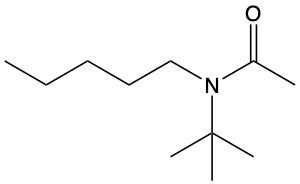
N-pentyl-N-tert-butylacetamide
N-tert-butyl-N-pentylethanamide
N-tert-butyl-N-pentylacetamide
N-hexyl-N-tert-butylethanamide
Draw a structure from the following name: N-cyclopentyl-N-propylvaleramide.
Do you want more practice?
Here’s what students ask on this topic:
What are the different types of amides and how are they classified?
Amides are classified into three types: primary, secondary, and tertiary. This classification is based on the number of carbon atoms directly attached to the nitrogen atom. In a primary amide, the nitrogen is attached to one carbon atom. In a secondary amide, the nitrogen is attached to two carbon atoms. In a tertiary amide, the nitrogen is attached to three carbon atoms. This classification helps in understanding the structure and reactivity of amides in organic chemistry.
 Created using AI
Created using AIHow do you name amides using IUPAC nomenclature?
In IUPAC nomenclature, the naming of amides involves modifying the name of the corresponding carboxylic acid. The suffix 'oic acid' of the carboxylic acid is replaced with 'amide'. For example, if the carboxylic acid is 'ethanoic acid', the corresponding amide would be 'ethanamide'. Additionally, any substituents attached to the nitrogen are named and prefixed with 'N-'. For instance, if there is a methyl group attached to the nitrogen, it would be named 'N-methyl'.
 Created using AI
Created using AIWhat is the difference between IUPAC and common naming of amides?
The IUPAC naming of amides involves using systematic rules where the suffix 'oic acid' of the corresponding carboxylic acid is replaced with 'amide'. In common naming, the parent chain uses common name prefixes, and the suffix 'amide' is added. For example, the IUPAC name 'propanamide' corresponds to the common name 'propionamide'. Substituents are named similarly in both systems, but the parent chain naming differs.
 Created using AI
Created using AIHow do you determine the parent chain in the common naming of amides?
In the common naming of amides, the parent chain is determined by identifying the longest carbon chain that includes the carbonyl group. The chain is named using common name prefixes such as 'form-', 'acet-', 'propion-', etc. For example, a three-carbon chain with a carbonyl group would be named 'propionamide'. Substituents attached to the nitrogen are named and listed alphabetically with the prefix 'N-'.
 Created using AI
Created using AIWhat is the significance of understanding the classification and naming of amides in organic chemistry?
Understanding the classification and naming of amides is crucial in organic chemistry because it helps in identifying the structure, reactivity, and properties of these compounds. Amides are important functional groups in many biological molecules and synthetic materials. Proper naming conventions allow chemists to communicate effectively about these compounds, predict their behavior in chemical reactions, and understand their role in various chemical processes.
 Created using AI
Created using AIYour GOB Chemistry tutor
- What are the names of the following compounds?c. <IMAGE>
- Identify the following molecules as an ester, a carboxylic acid, or an amide, and write both the condensed and...
- Give systematic names for the following structures and structures for the names:c. N-Ethyl-N-methylbenzamide
- Give systematic names for the following structures and structures for the names:a. 3-Methylpentanamide
- Give systematic names for the following structures and structures for the names:b. N-Phenylacetamide
- Write the IUPAC and common names, if any, for each of the following amides:c. <IMAGE>
- Draw the condensed structural formula for each of the following amides:b. 2-methylpentanamide
- Draw the condensed structural formula for each of the following amides:a. heptanamide
- Draw the condensed structural formula for each of the following amides:c. 3-methylbutyramide
- There are four amide isomers with the molecular formula C3H7NO. Draw their condensed structural formulas and w...
- Write the IUPAC name for each of the following: (14.6)b . <IMAGE>
- Write the IUPAC and common name, if any, for each of the following carboxylic acids:b. <IMAGE>
